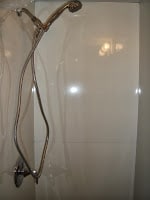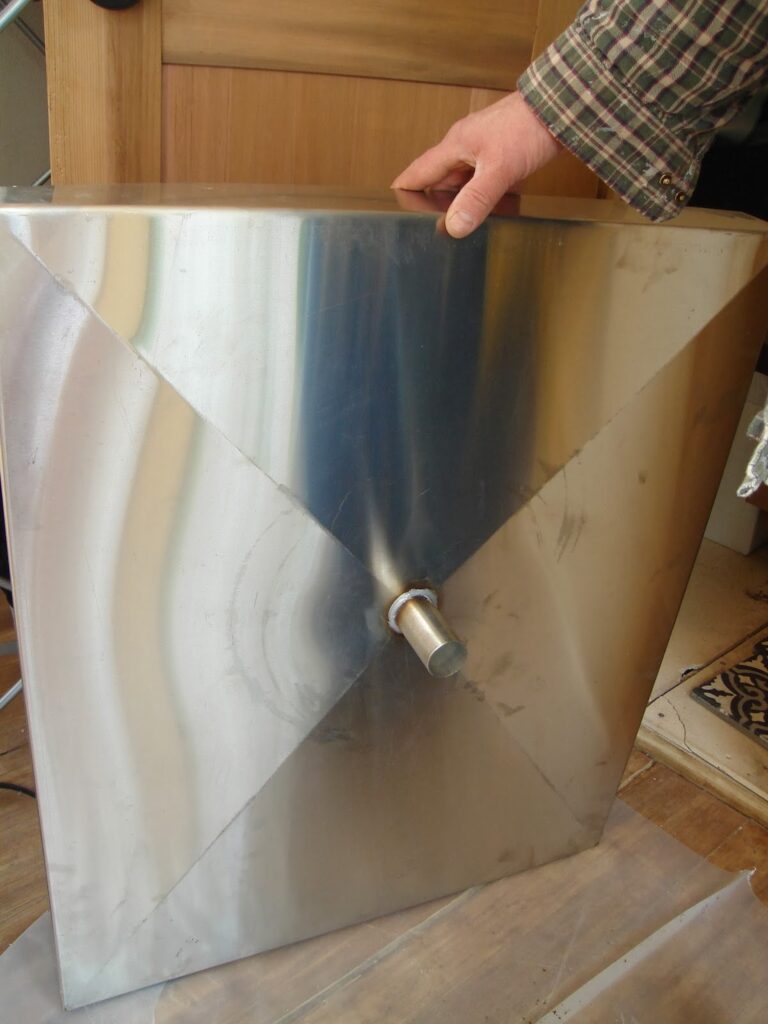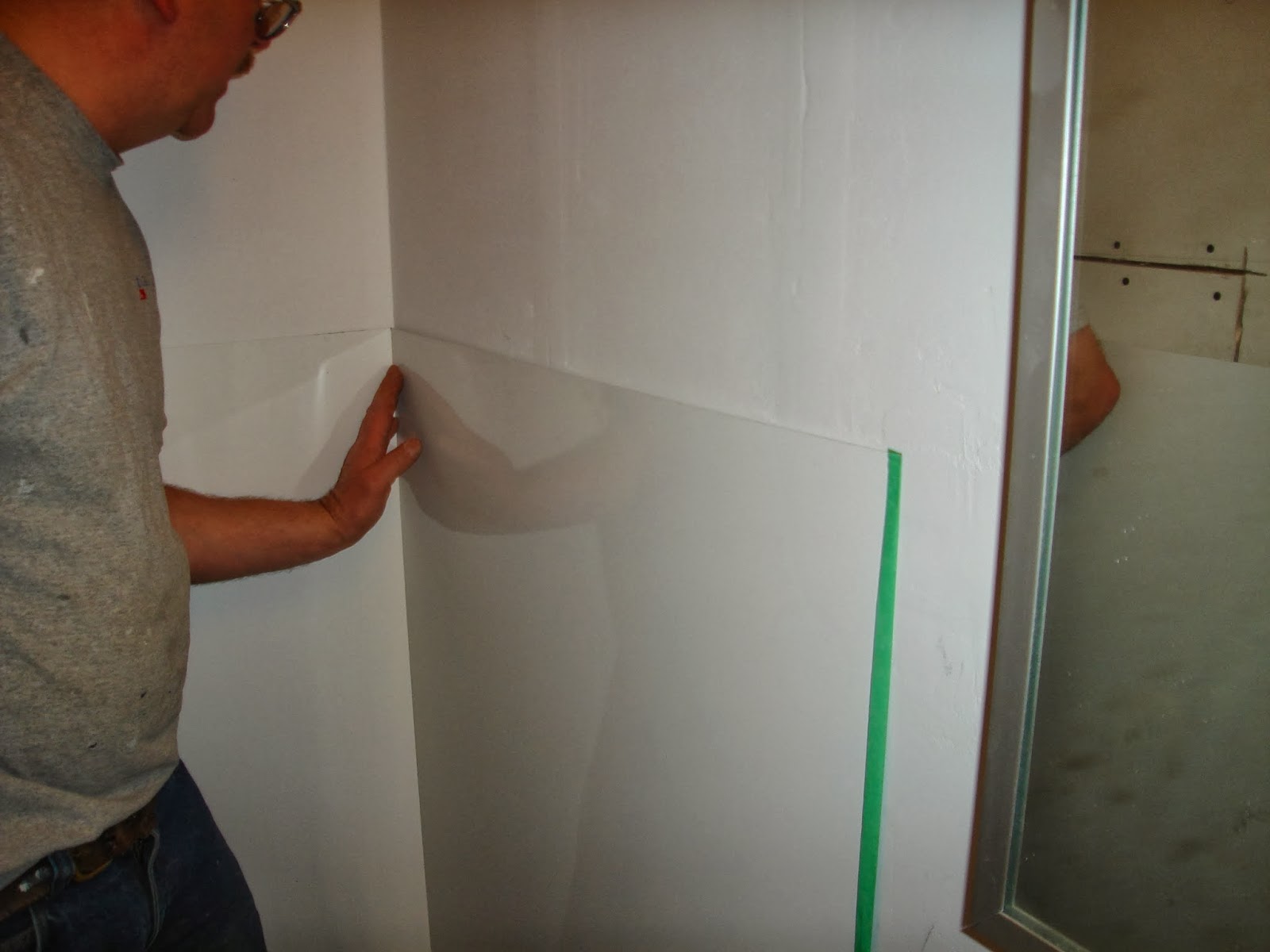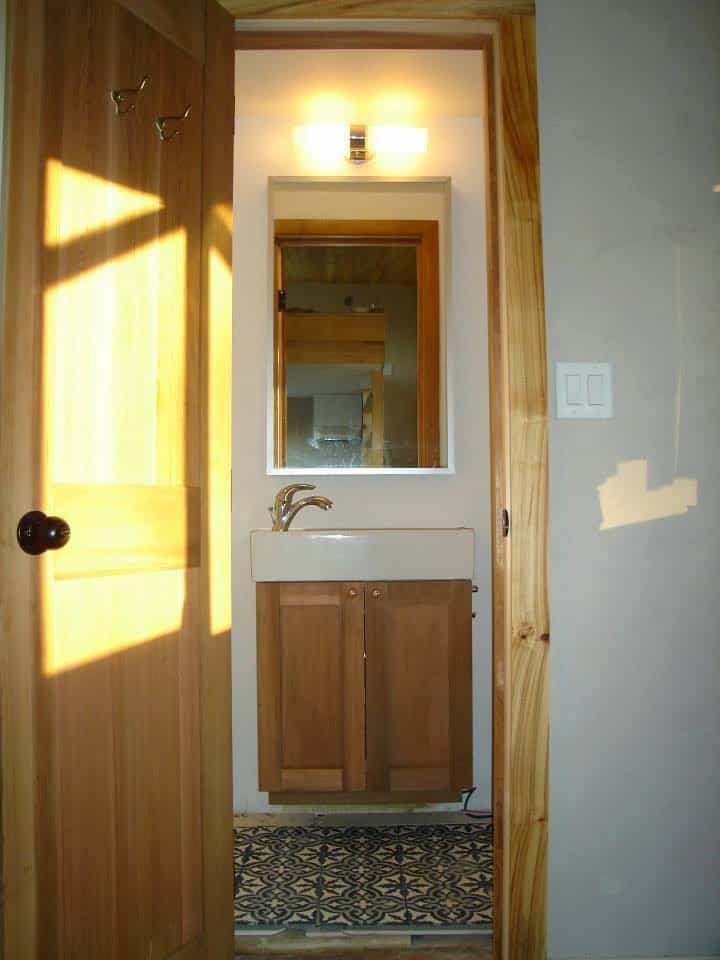This post contains affiliate links. Upon purchase, I earn a small commission at no extra cost to you.
Non-Toxic Shower Options that I Considered
Tiles
My first plan when designing my tiny house was to use tiles. But because grout without additives (plain Portland Cement) may not hold up in the long run to mold or to cracks in a mobile house I decided against it.
Even with the recommended Schulter shower system, I still wasn’t confident that the area around the drain would hold up to cracks when the house moved. This would be better in a non-mobile tiny home.
(I go through non-toxic tile options in the post on bathrooms).
Tadelakt
A non-toxic waterproof finish, tadelakt is a beautiful option. But in my house on wheels, all the plaster has cracked.
We came up with some ideas to give it a little flex including adding glue to the plaster and maybe a mesh underneath on the wall, but no one had tried this yet in a mobile home so it was big risk and I don’t think it’s a good idea.
In a tiny house (not on a trailer) this would be a good choice for many people.
Though it requires a lot of upkeep. (For the base/floor you still need tiles, fiberglass, or metal) otherwise it tends towards mold.
Make sure you can commit!
Fiberglass or Acrylic
These will last a lifetime without getting moldy but if you get a company to install it they need to use their own adhesive, which could be toxic.
Fiberglass offgasses and most highly sensitive people say they react to it. Acrylic is much more tolerable and should become odorless quite quickly. You can offgass them outside until they are ready.
If you use one of these showers in a new build you have to design the size of the bathroom around that (I didn’t!).
Use AFM Almighty Adhesive to install them.
Solid surface showers are beautiful and non-toxic but be sure to check the glue.
Other Options
In a larger house, polished concrete might work really well, if you can find someone who can do that finish on walls and tight spaces.
Glass walls are something to consider.
An outdoor shower could be made of cedar, glass, or concrete.
More discussion on these materials in my post on bathrooms.
My Shower for Tiny Houses on Wheels (Could work in Trailers, and RVs too)

It took four people, five months to design, make, and install a totally toxin-free shower for my tiny house on wheels that will:
-last a very long time
-and hold up in a tiny mobile home (that flexes when it moves)!
-not aggravate my chemical sensitivities
But we did it! We were this close to giving up and building an outdoor shower. In the end, the shower enclosure was made of aluminum and stainless steel with a zero VOC adhesive.

I would have done more of a grade and a higher lip on the basin if I did it again.
Underneath we used pieces of acrylic and Butyl Sealant Tape to support the grade.

There are two sheets of thin aluminum panels that wrap around the three-wall shower enclosure.
The first piece of aluminum wraps around the three walls (no seams in the corners) and overlaps with the basin at the bottom (will never leak at that point).
The second piece of aluminum overlaps over the first piece and goes up to the ceiling. A vent is right in the middle of the shower on the ceiling to reduce moisture.
Please consider that these sheets of aluminum and stainless pan are a vapor barrier and can cause a point of condensation and potentially mold if you use AC inside. Schulter foam boards used behind the shower can mitigate this.

The shower curtain is an EVA non-toxic one (had a slight plastic smell but was fine for me) (other curtain options to try are polyester or polyethylene – or, even better make a glass door).
My curtain has magnetic pieces that stick to the walls – to prevent water from splashing out onto the tiles which are not 100% waterproof (magnetic strips from Bed Bath and Beyond).
After testing many adhesives with no luck I finally found Almighty Adhesive by AFM and had no reaction at all to it even when wet!
The problem of finding an adhesive was holding up the project for months and I was so excited to finally find this. It is also the only adhesive (including silicones) I have ever smelled that really is non-toxic. Even a regular non-toxic white glue smells more than this stuff.
Around the edge of the aluminum will be sealed with AFM caulk which does take about a week to offgas.
I really want all the edges to be sealed. Strangely (happily) I no longer find this caulking to be problematic.
So there you have it! A shower that will never leak and with no toxins!

Notes:
Another thing to consider is to weld all the parts together. See Tiny Green Cabins stainless steel showers if you are interested in that route.
The custom aluminum and stainless cost 800 CAD + installation which took 2 people all day. (We had to re-do some plumbing though which took longer than expected)
Corinne Segura holds certificates in Building Biology, Healthier Materials and Sustainable Buildings, and more. She has 10 years of experience helping others create healthy homes.
Did you find this post helpful? If so you can buy me a coffee to support the research behind this blog. Thank you!
Nea
I too would like to know, please, what handheld shower you purchased here.
Just like Liz Green I would also appreciate some resources for easy screw on handheld showers that are Lead Free, PVC Free, BPA Free, and otherwise as non-toxic as possible, if it even exists.
Kay
I would also like to know more about your mom toxic shower head. Thank you in advance for your thoughts!
Liz Greene
I am trying to find a non-toxic, hand held shower head that will easily screw on with my hands or a wrench. No BPH, no PVC, no lead. Can you recommend a few choices?
Unknown
What size is your shower and what size curtain did you get?
Corinne
It's about 30×30, I had to cut down a regular shower curtain
Shanna
Hi Corinne, why did you choose aluminum for the walls instead of stainless throughout? Do you know anyone that makes SS shower enclosures or would we need to find someone who would make this on a one off basis. I'm trying to plan a non toxic travel trailer. Thanks 🙂
Corinne
It's cheaper
Unknown
I have a question about plumbing, particularly tub sputs, shower heads, valvs, etc. I was hoping I maybe missed it somewhere in your article, but I didn't see this topic brought up. I recently stumbled upon some disappointing news about plumbing containing high amounts of lead in it. Brass especially will have lead in it. I called over 20 companies and all admitted to using lead in their products. A few articles I came across about this topic made mention that the lead from the plumbing leeches into the water supply. The US government has a "standard " where no more than 11ppb of lead is allowed to be leached into the water, but that's only in the kitchen, where they deem the water "drinkable." Currently, there are no standards for bathroom appliances, so even more lead is found in those fixtures. What are your thoughts on this? I wanted to give my son detox baths, but don't feel comfortable doing so with all that lead content in the water. I am very anxious bc of how many toxins are being found in so may things. Any info will help, no one seems to have answers. And I don't want plastic spouts or shower heads. I love all your articles!
Corinne
Check out this article https://www.safeplumbing.org/health-safety/lead-in-plumbing maybe test your bathroom water for lead and then put in a carbon block filter.
Anna johnson
Thank you! I will look into it, I appreciate the references
Anna johnson
That site offered limited help; they did not direct me to actual companies. It took me some time, but I was able to track down an American based company that made solid 304 stainless steel bathroom plumbing fixtures. There were a few companies that made kitchen fixtures out of stainless steel, but to find a company that included bathrooms was almost impossible. They do use a little bit of plastic in their showerhead though (vents) and not sure about spouts bc I am still waiting to hear back. They use ceramic valves. There is a Chinese and Italian company as well; the Italian company seems to be the most pure but it costs thousands of dollars!
As far as carbon block filters, do you know if they make them for tub spouts?
Corinne
I would put in a shower filter and fill up the tub that way.
Sabrina
Parmir out of San Diego makes 100% lead-free stainless plumbing fixtures. Even the flexible shower hose tubes are silicone, which is incredible–try finding PVC-free tubes anywhere!!! We are using their products exclusively in our home remodel–kitchen, lavatory and shower/tubs.
Sabrina
http://www.parmirus.com/
Alissa
I know this comment is from a long time ago but if anyone is reading this post now like I am, I hope this helps. I’m doing a DIY THOW and we chose to use Aquatherm polypropylene pipes for all our fresh water in. It is completely nontoxic, no leaching and even turns into water vapors if it was to catch on fire (unlike PVC or PEX). It’s good for you and the planet. The rep actually came out to teach my husband himself & it only cost us about $200 in material (the rep taught for free & loaned his tool for it at no charge). If you find a plumber that can do it, they majorly upcharge as there’s so few people that do it & it’s a little more entailed.
For your own good
I would love to know the price the rest of us should expect to pay for a job like this.
Corinne
The cost is at the bottom of the post!
Kelly Boffman
My husband and 1 year old son are allergic to mold, my son especially. We are planning on building a non-toxic mold resistant tiny house next year. Do you have and suggestions for a shower tub combo for a tiny house, having a little one and hoping to have more, I'd really like to have a tub option as well.
Corinne
I don't know of any in particular but I have seen tiny club claw tubs which are really cute. I have also seen people make their own with large metal basins.
Jubilant Nest
We love this idea! What did you use to seal the aluminum and make it that nice and shiny white?
Corinne
you can buy the aluminum already coated. I believe it offgasses very quickly once cured.
Mary Duran
I made a shower curtain made from a fine vintage cotton percale sheet. Works great and to clean I just wash it with the bed linens. If you can't fine vintage, use an organic cotton fine woven sheet.
Hunter
I am having a horrid time trying to repair the walls of a shower.
Only about 5 feet from the top top needs to be replaced the rest is intact tile.
I'd be grateful if you wouldn't mind answering some questions
Your aluminum panels sound great where did you buy them / what manufacturer?
Did you have a backerboard? if so what kind?
If not did you just attache to the wall frame 2X$s (I think they are called studs ; )
or something else?
how did you attach it? adhesive? what kind?
thanks
Hunter
Correction:
If not did you attach to the wall frame 2x4s
sorry
Corinne
Hi Hunter, the walls were custom made my a metalworker/welder. Just a shop that does metal works. The walls are Magnsium Oxide Board (Dragon Board is one good brand in the US). I wouldn't skip the backerboard. The aluminum is attached to the MgO board with the Almighty Adhesive that I mention in the post
Liz
What kind of backboard would you recommend?
Corinne
For the metal walls, we used a concrete backer board because the metal was rather thin but WEDI or Schulter board probably would have been better. I would get some technical advice there.
Unknown
THANK YOU THANK YOU THANK YOU!!! I've just discovered your blog, and after hours of research to find a light-weight nontoxic way to build a shower, reading this particular blog post made me very happy. I was not looking forward to all of the testing-and-getting-sick that the build process would cause me. I know we each react a bit differently (we canaries in the coal mine), but you've given me a lot of great ideas, and a place to start. Thank you!!
Jones Morris
I have read a few of the articles on your website now, and I really like your style of blogging. I added it to my favorites blog site list and will be checking back soon. Please check out my site as well and let me know what you think. shower filter reviews